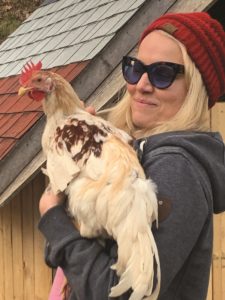The days are getting longer and lighter at last, heralding the season of birds and bees. When it comes to those of us with yard birds, it is time to think about whether we’ll have new chicks this spring, and, if so, where they’ll come from.
In the past, we’ve gone the mail-order route. This year, we decided to produce our own. What we have learned so far is that, while the question of which came first, the chicken or the egg, remains unanswerable, we can declare with certainty that, if a chick is to be born, a rooster must come first.
Most homesteaders don’t keep roosters for one obvious reason: they crow at dawn, and often don’t stop singing until they hit the roost again at dusk. A rooster’s crow has nothing to do with waking up the farm — that myth was born of our human tendency to put ourselves at the center of all things. Roosters are territorial creatures, and their crowing is a means of marking and protecting their land and flock. Crowing is also intended to impress the ladies, so to speak, especially in the mating season. Which is, ideally, now.
A handsome rooster can be up to twice the size of a chicken and will sport spectacular plumage. His colorful feathers are a sign of health and strength, to prove he’d be a worthy mate. Not that there is much in the way of choice or courtship with chickens. It is not pretty the way a rooster tackles his mate and presses her to the ground while she squawks, though the whole affair lasts only a few seconds.

We’re hoping Rooster Cogburn, the gentle 18-week-old Ancona we’ve introduced to our flock of hens, will be more charming.
Many roosters engage in some form of flirtation involving a short dance in front of a chosen partner. Some are even suave ballerinos, who go so far as to lift a leg and splay a wing for the lady. And I’ve mentioned tidbitting before, where he lures her with the promise of food. While roosters will mate with all the hens in their flock, they sometimes choose a queen, one bird they prefer over all others. The other chickens often become jealous and harass this sister if the rooster is not close by.
There is good reason for the awkward drama of chicken pairings: the rooster does not have an appendage for conveniently transferring semen where it needs to go. Both male and female birds have a cloaca under their tails. Though the word is from the Latin for “sewer,” the cloaca, in both cases, is a cleverly designed all-purpose canal. The two cloacas must meet so that the rooster’s sperm can reach an egg’s nucleus as it leaves the ovary, before the shell develops around it.
Once a hen is mated, she can produce fertile eggs for up to three weeks. That doesn’t stop the rooster from trying again, however. Roosters will mate up to 30 times a day. Which is why deciding on a ratio of roosters to hens involves careful consideration: too many hens can exhaust the rooster, while too few can lead to ravished hens. The ideal number of hens for a flock with one rooster is 10 to 12, and a rooster should be kept with no fewer than four hens.
Mating season can be surprisingly dangerous for both sexes. When a rooster is “treading” on a chicken — holding her down to get situated — he can injure her. And even young roosters can suffer from heart attacks while copulating. Older ones often die during or after mating season, exhausted and depleted from their efforts.
We look forward to the happy result of all this mayhem. If we have at least one broody hen, we’ll let her sit peacefully on a clutch of fertile eggs, with food and water nearby. She will stop laying and stay sitting for 21 days. The hatchling report will follow.



